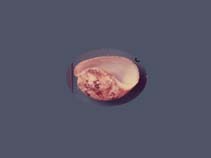Bulla ampulla (Linnaeus, 1758)
Pacific blue snailWarning: DOMDocument::load(): SSL operation failed with code 1. OpenSSL Error messages: error:140770FC:SSL routines:SSL23_GET_SERVER_HELLO:unknown protocol in C:\Apache24\htdocs\includes\SpeciesSummary.lib.php on line 1236
Warning: DOMDocument::load(): Failed to enable crypto in C:\Apache24\htdocs\includes\SpeciesSummary.lib.php on line 1236
Warning: DOMDocument::load(https://sealifebase.nrm.se/webservice/AquaMaps/getAMap.php?genus=Bulla&species=ampulla): failed to open stream: operation failed in C:\Apache24\htdocs\includes\SpeciesSummary.lib.php on line 1236
Warning: DOMDocument::load(): I/O warning : failed to load external entity "https://sealifebase.nrm.se/webservice/AquaMaps/getAMap.php?genus=Bulla&species=ampulla" in C:\Apache24\htdocs\includes\SpeciesSummary.lib.php on line 1236
Classification / Names Common names | Synonyms | CoL | ITIS | WoRMS
| Cephalaspidea | Bullidae
Environment: milieu / climate zone / depth range / distribution range экология
; пределы глубины 0 - 165 m (Ref. 107300). Tropical
распространение страны | регионы FAO | Ecosystems | места находок | интродукции
Indo-Pacific, Southeast Atlantic and the Mediterranean.
Length at first maturity / Size / Вес / Возраст
Maturity: Lm ? range ? - ? cm Max length : 5.0 cm TL самец/пол неопределен; (Ref. 844)
Assumed maximum length from Ref. 844. A strictly herbivorous species that is common on rocky reefs (Ref. 844), and always found around soft silt or mud in where it is usually buried (Ref. 866) during the day (Ref. 107294); common in deep rock pools and tidal swimming pools (Ref. 866). Nocturnal. Emerges at night to feed on seaweeds and grasses (Ref. 107294).
Life cycle and mating behavior половая зрелость | размножение | нерест | икра | Fecundity | личинки
Members of the order Cephalaspidea are mostly simultaneous hermaphrodites.
Основная ссылка
ссылки | координатор | соавторы
Debelius, H. 2001. (Ref. 844)
Статус Красного Списка МСОП (Ref. 130435)
Статус СИТЕС (Ref. 108899)
Not Evaluated
CMS (Ref. 116361)
Not Evaluated
Угроза для людей
Использование человеком
| FishSource |
инструменты
дополнительная информация
Возраст/Размеры
рост
Зависимость между длиной и массой тела
Зависимость между длинами
морфология
личинки
численность
рост
Зависимость между длиной и массой тела
Зависимость между длинами
морфология
личинки
численность
ресурсы в Интернет
BHL | BOLD Systems | CISTI | DiscoverLife | FAO(Publication : search) | Fishipedia | GenBank (Геном, Нуклеотид) | GloBI | Gomexsi | Google Books | Google Scholar | Google | PubMed | Tree of Life | Wikipedia (Вперёд, поиск) | Zoological Record
Estimates based on models
Preferred temperature
(Ref. 115969): 23.7 - 29, mean 27.5 (based on 986 cells).
Категория цены
(Ref. 80766):
Unknown.



